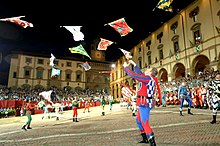
The 1848 Revolutions in the Italian states, part of the wider Revolutions of 1848 in Europe, were organized revolts in the states of the Italian peninsula and Sicily, led by intellectuals and agitators who desired a liberal government. As Italian nationalists they sought to eliminate reactionary Austrian control. During this time, Italy was not a unified country, and was divided into many states, which, in Northern Italy, were ruled directly or indirectly by the Austrian Empire. A desire to be independent from foreign rule, and the conservative leadership of the Austrians, led Italian revolutionaries to stage revolution in order to drive out the Austrians. The revolution was led by the state of the Kingdom of Sardinia. Some uprisings in the Kingdom of Lombardy–Venetia, particularly in Milan, forced the Austrian General Radetzky to retreat to the Quadrilateral fortresses.

The national flag of Italy, often referred to in Italian as il Tricolore, is a tricolour featuring three equally sized vertical pales of green, white and red, national colours of Italy, with the green at the hoist side, as defined by article 12 of the Constitution of the Italian Republic. The Italian law regulates its use and display, protecting its defense and providing for the crime of insulting it; it also prescribes its teaching in Italian schools together with other national symbols of Italy.

Francesco Ferdinando Alfieri was a master of fencing of the 17th century. He was a representative of the Venetian school of fencing and “Maestro D’Arme” to the Accademia Delia in Padua in 1640. Alfieri was originally from Padua, which at that time was considered territory of the Venetian Republic.

The emblem of the Italian Republic was formally adopted by the newly formed Italian Republic on 5 May 1948. Although often referred to as a coat of arms, it is an emblem as it was designed not to conform to traditional heraldic rules. The emblem is used extensively by the Italian government.

The Italy Pavilion is an Italian-themed pavilion that is part of the World Showcase, within Epcot at Walt Disney World in Bay Lake, Florida, United States. Its location is between the Germany pavilion and The American Adventure.

The Flags of Napoleonic Italy were the green, white and red tricolour flags and banners in use in Italy during the Napoleonic era, which lasted from 1796 to 1814. During this period, on 7 January 1797, the green, white and red tricolour was officially adopted for the first time as a national flag by a sovereign Italian state, the Cispadane Republic. This event is commemorated by the Tricolour Day.

Ettore Ovazza was an Italian Jewish banker. He was an early financer of Benito Mussolini, of whom he was a personal friend, and Italian fascism, which he supported until the Italian racial laws of 1938. He founded the journal La nostra bandiera. Believing that his position would be restored after the war, Ovazza stayed on after the Germans marched into Italy. Together with his wife and children, shortly after the Fall of Fascism and Mussolini's government during World War II, he was executed near the Swiss border by SS troops in 1943.

Without a Flag is a 1951 Italian drama film directed by Lionello De Felice and starring Massimo Serato, Paolo Stoppa and Walter Rilla.
National symbols of Italy are the symbols that uniquely identify Italy reflecting its history and culture. They are used to represent the Nation through emblems, metaphors, personifications, allegories, which are shared by the entire Italian people.

The national colours of Italy are green, white, and red, collectively known in Italian as il Tricolore. The three Italian national colours appeared for the first time in Genoa on 21 August 1789 on the cockade of Italy shortly after the outbreak of the French Revolution, on 11 October 1796 they were used for the first time in Milan on a military banner, while on 7 January 1797 in Reggio Emilia they appeared for the first time on a flag.

Raffaele Calzini was an Italian art critic and writer. His novel Segantini, romanzo della montagna, about the short-lived Alpine painter Giovanni Segantini, won the Premio Letterario Viareggio Rèpaci in 1934.

Tricolour Day, officially National Flag Day, is the flag day of Italy. Celebrated on 7 January, it was established by Law 671 on 31 December 1996. It is intended as a celebration, though not a public holiday. The official celebration of the day is held in Reggio Emilia, the city where the Italian tricolour was first adopted as flag by an Italian sovereign state, the Cispadane Republic, on 7 January 1797.

The flag of Liguria is one of the official symbols of the region of Liguria, Italy. The current flag was adopted on 7 July 1997.

The flag of Umbria is one of the official symbols of the region of Umbria, Italy. The current flag was officially adopted on 18 March 2004, although the emblem and gonfalon had been in use since the 1970s. The Regional Law of 18 May 2004 officially confirmed the flag and added the words Regione Umbria in red, centered in the bottom fifth of the flag, but in common usage, the words are omitted.

The cockade of Italy is the national ornament of Italy, obtained by folding a green, white and red ribbon into a plissé using the technique called plissage (pleating). It is one of the national symbols of Italy and is composed of the three colours of the Italian flag with the green in the centre, the white immediately outside and the red on the edge. The cockade, a revolutionary symbol, was the protagonist of the uprisings that characterized the Italian unification, being pinned on the jacket or on the hats in its tricolour form by many of the patriots of this period of Italian history. During which, the Italian Peninsula achieved its own national unity, culminating on 17 March 1861 with the proclamation of the Kingdom of Italy. On 14 June 1848, it replaced the azure cockade on the uniforms of some departments of the Royal Sardinian Army, while on 1 January 1948, with the birth of the Italian Republic, it took its place as a national ornament.

The flag of Lombardy is one of the official symbols of the region of Lombardy, Italy. The current flag was officially adopted on 4 February 2019, although it has been used de facto since 12 June 1975.

Tear Along the Dotted Line is a 2021 Italian adult animated comedy drama series written and directed by Italian cartoonist Zerocalcare. It follows Zero, a fictionalized version of Zerocalcare, who reflects on his path in life and a would-be love as he travel outside Rome with his friends Secco and Sara and his armadillo-for-a-conscience. The series is inspired by actual experiences lived by Zerocalcare, who voices most of the characters in the original version. It was released internationally on Netflix on 17 November 2021 to generally positive reviews from critics.
















